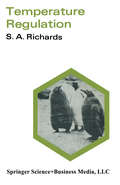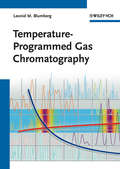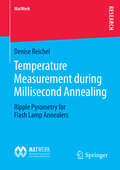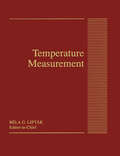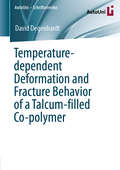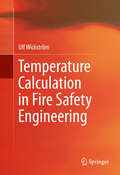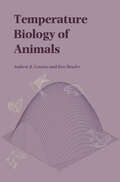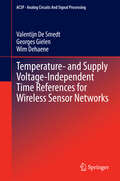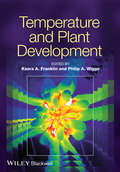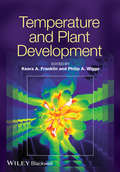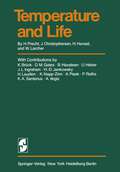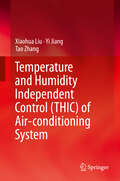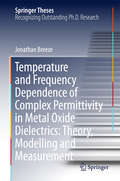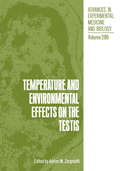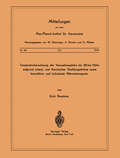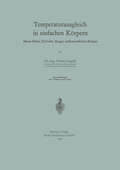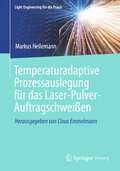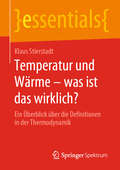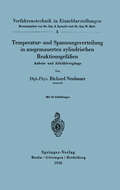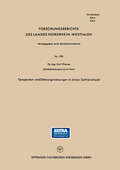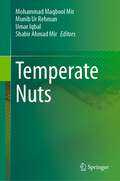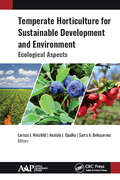- Table View
- List View
Temperature Regulation
by Stewart RichardsMANY aspects of physiology are best understood in terms of bodily reactions to environmental stress, and temperature is one of the most often encountered stress factors in the environment. The responses to temperature can involve practically all of the organ systems of the body and it is for this reason that the study of the regulation of body temperatures represents one of the finest examples of complex reaction integrated by the nervous and endocrine systems, and hence of the principles of biological control. Thus, while thermoregulation offers an abundance of opportunities for the individual who likes to specialize in depth, it is an ideal type of physiology for those who prefer to think of the functioning of the body as whole. This book is written primarily for the undergraduate, but I hope also that some students may find time to read it, before embarking on a university course, as an introduction to some of the ideas that will be encountered in the more detailed study of the biological sciences, including medicine. I have tried to discuss the evidence for important ideas, since this is fundamental to the scientific method, and have been particularly concerned to avoid the use of the sort of technical jargon that gives a spurious impression of authority while in reality creating confusion out of what is in essence simple.
Temperature-Programmed Gas Chromatography
by Leonid M. BlumbergThis book provides a comprehensive up-to-date overview of temperature-programmed gas chromatography (GC). The first part of the book introduces the reader to the basics concepts of GC, as well as the key properties of GC columns. The second part describes the mathematical and physical background of GC. In the third part, different aspects in the formation of a chromatogram are discussed, including retention times, peak spacing and peak widths. An invaluable reference for any chromatographer and analytical chemist, it provides all the answers to questions like: At what temperature does a solute elute in a temperature-programmed analysis? What is the value of the retention factor of eluting solute? How wide are the peaks? How large is the time distance between two peaks? How do all these parameters depend on the heating rate?
Temperature-Programmed Gas Chromatography
by Leonid M. BlumbergThis book provides a comprehensive up-to-date overview of temperature-programmed gas chromatography (GC). The first part of the book introduces the reader to the basics concepts of GC, as well as the key properties of GC columns. The second part describes the mathematical and physical background of GC. In the third part, different aspects in the formation of a chromatogram are discussed, including retention times, peak spacing and peak widths. An invaluable reference for any chromatographer and analytical chemist, it provides all the answers to questions like: At what temperature does a solute elute in a temperature-programmed analysis? What is the value of the retention factor of eluting solute? How wide are the peaks? How large is the time distance between two peaks? How do all these parameters depend on the heating rate?
Temperature Measurement during Millisecond Annealing: Ripple Pyrometry for Flash Lamp Annealers (MatWerk)
by Denise ReichelDenise Reichel studies the delicate subject of temperature measurement during lamp-based annealing of semiconductors, in particular during flash lamp annealing. The approach of background-correction using amplitude-modulated light to obtain the sample reflectivity is reinvented from rapid thermal annealing to apply to millisecond annealing. The author presents a new method independent of the lamp operation to obtain this amplitude modulation and derives a formula to describe the process. Further, she investigates the variables of the formula in depth to validate the method’s suitability for background-corrected temperature measurement. The experimental results finally proof its power for elevated temperatures.
Temperature Measurement
by Bela G. LiptakTemperature Measurement covers nearly every type of temperature measurement device, in particular, bimetallic thermometers, filled bulb and glass stem thermometers, thermistors, thermocouples, and thermowells. Includes suppliers and prices.Béla G. Lipták speaks on Post-Oil Energy Technology on the AT&T Tech Channel.
Temperature Measurement
by Bela G. LiptakTemperature Measurement covers nearly every type of temperature measurement device, in particular, bimetallic thermometers, filled bulb and glass stem thermometers, thermistors, thermocouples, and thermowells. Includes suppliers and prices.Béla G. Lipták speaks on Post-Oil Energy Technology on the AT&T Tech Channel.
Temperature-dependent Deformation and Fracture Behavior of a Talcum-filled Co-polymer (AutoUni – Schriftenreihe #147)
by David DegenhardtDavid Degenhardt develops an elasto-viscoplastic material model in order to predict the temperature and strain rate-dependent deformation and fracture behavior of thermoplastic polymers. The model bases on three supporting ambient temperatures, where a thermoplastic polymer has been characterized profoundly at the stress states 1) uni-axial tension and compression, 2) bi-axial tension and 3) shear. The core of the material model builds a pressure-dependent yield function with a non-associated flow rule. Further, it contains an analytical hardening law and a strain rate-dependent fracture criterion. The model is validated with components subjected to impact loading at different ambient temperatures. The comparison of the simulation and the experiments shows that stiffness, hardening, fractures strain as well as thicknesses can be well captured.About the Author:David Degenhardt is a calculation engineer in the chassis development department of a German automobile manufacturer and earned his doctorate while working at the Technische Universität Carolo-Wilhelmina zu Braunschweig, Germany.
Temperature Calculation in Fire Safety Engineering
by Ulf WickströmThis book provides a consistent scientific background to engineering calculation methods applicable to analyses of materials reaction-to-fire, as well as fire resistance of structures. Several new and unique formulas and diagrams which facilitate calculations are presented. It focuses on problems involving high temperature conditions and, in particular, defines boundary conditions in a suitable way for calculations. A large portion of the book is devoted to boundary conditions and measurements of thermal exposure by radiation and convection. The concepts and theories of adiabatic surface temperature and measurements of temperature with plate thermometers are thoroughly explained.Also presented is a renewed method for modeling compartment fires, with the resulting simple and accurate prediction tools for both pre- and post-flashover fires. The final chapters deal with temperature calculations in steel, concrete and timber structures exposed to standard time-temperature fire curves. Useful temperature calculation tools are included, and several examples demonstrate how the finite element code TASEF can be used to calculate temperature in various configurations. Temperature Calculation in Fire Safety Engineering is intended for researchers, students, teachers, and consultants in fire safety engineering. It is also suitable for others interested in analyzing and understanding fire, fire dynamics, and temperature development. Review questions and exercises are provided for instructor use.
Temperature Biology of Animals
by Andrew CossinsTemperature is one facet in the mosaic of physical and biotic factors that describes the niche of an animal. Ofthe physical factors it is ecologically the most important. for it is a factor that is all-pervasive and one that. in most environments. lacks spatial or temporal constancy. Evolution has produced a wide variety of adaptive strategies and tactics to exploit or deal with this variable environmental factor. The ease with which temperature can be measured. and controlled experimentally. together with its widespread influence on the affairs of animals. has understandably led to a large. dispersed literature. In spite of this no recent book provides a comprehensive treatment of the biology of animals in relation to temperature. Our intention in writing this book was to fill that gap. We hope we have provided a modern statement with a critical synthesis of this diverse field. which will be suitable and stimulating for both advanced undergraduate and post graduate students of biology. This book is emphatically not intended as a monographical review. as thermal biology is such a diverse. developed discipline that it could not be encompassed within the confines of a book of this size.
Temperature- and Supply Voltage-Independent Time References for Wireless Sensor Networks (Analog Circuits and Signal Processing #128)
by Valentijn De Smedt Georges Gielen Wim DehaeneThis book investigates the possible circuit solutions to overcome the temperature and supply voltage-sensitivity of fully-integrated time references for ultra-low-power communication in wireless sensor networks. The authors provide an elaborate theoretical introduction and literature study to enable full understanding of the design challenges and shortcomings of current oscillator implementations. Furthermore, a closer look to the short-term as well as the long-term frequency stability of integrated oscillators is taken. Next, a design strategy is developed and applied to 5 different oscillator topologies and 1 sensor interface. All 6 implementations are subject to an elaborate study of frequency stability, phase noise and power consumption. In the final chapter all blocks are compared to the state of the art.
Temperature and Plant Development
by Keara Franklin Philip WiggePlants are incredibly sensitive to changes in temperature. Changes of a single degree or two in ambient temperature can impact plant architecture, developmental processes, immune response, and plant reproduction. Temperature and Plant Development thoroughly explores plant molecular responses to changes in temperature with aim to understanding how plants perceive, integrate, and respond to temperature signals. Temperature and Plant Development explores the diverse molecular responses that plants exhibit as they face changing temperatures. Temperature-related changes and adaptations to essential developmental processes, such as germination, flowering, and reproduction, are explored in detail. Chapters also explore the impact of temperature on plant immune responses and the impact of rising temperatures on global food security. A timely and important book, Temperature and Plant Development will be a valuable resource for plant biologists, crop scientists, and advanced students. • Up-to-date and comprehensive coverage of the role of temperature on plant development. • Looks at changes and adaptations to plant developmental processes made in response to changing temperatures. • Explores the role of temperature on plant immune response and pathogen defense • Provides a timely look at the impact of changing temperatures on global food security
Temperature and Plant Development
by Keara Franklin Philip WiggePlants are incredibly sensitive to changes in temperature. Changes of a single degree or two in ambient temperature can impact plant architecture, developmental processes, immune response, and plant reproduction. Temperature and Plant Development thoroughly explores plant molecular responses to changes in temperature with aim to understanding how plants perceive, integrate, and respond to temperature signals. Temperature and Plant Development explores the diverse molecular responses that plants exhibit as they face changing temperatures. Temperature-related changes and adaptations to essential developmental processes, such as germination, flowering, and reproduction, are explored in detail. Chapters also explore the impact of temperature on plant immune responses and the impact of rising temperatures on global food security. A timely and important book, Temperature and Plant Development will be a valuable resource for plant biologists, crop scientists, and advanced students. • Up-to-date and comprehensive coverage of the role of temperature on plant development. • Looks at changes and adaptations to plant developmental processes made in response to changing temperatures. • Explores the role of temperature on plant immune response and pathogen defense • Provides a timely look at the impact of changing temperatures on global food security
Temperature and Life
by Herbert PrechtThe book by PRECHT, CHRISTOPHERSEN and HENSEL referred to in the text as the first edition was published in German in 1955 with the title Temperatur und Leben. The present volume is a revised version of this book, constructed along the same lines, but it cannot properly be called the second edition because it is in English. Yet another difference is in the number of contributors, who now include two microbiologists, seven botanists, three zoophysiologists, one biochemist, and three human physiologists. We have again endeavored to treat as many problems as possible but the main theme is still the adaptation of organisms to changing temperatures. What was conceived as a chapter on physical and chemical aspects by Professor L. LUMPER of GieBen will be published later as a supplementary volume. A special effort has been made to cover the copious literature published since 1955 though not, of course, exhaustively. The various chapters were completed at different times and those written earlier have footnotes referring to subsequent literature. The botanical contributions by W. LARCHER, K. NAPP-ZINN and A. PISEK were translated by Mrs. JOY WIESER; Dr. J. M. AUGENFELD was the translator of those on poikilotherms by H. D. JANKOWSKY, H. LAUDIEN and H. PRECHT as well as of those on homeotherms by H. HENSEL, K. BRUCK and P. RATHS. The section on limiting temperatures by H. PRECHT was translated by HAZEL PROSSER. We are grateful to them for undertaking this work.
Temperature and Humidity Independent Control (THIC) of Air-conditioning System
by Xiaohua Liu Yi Jiang Tao ZhangTemperature and Humidity Independent Control (THIC) of Air-conditioning System focuses on temperature and humidity independent control (THIC) systems, which represents a new concept and new approach for indoor environmental control. This book presents the main components of the THIC systems, including dehumidification devices, high-temperature cooling devices and indoor terminal devices. Other relevant issues, such as operation and control strategy and case studies, are also included.This book is intended for air-conditioning system designers and engineers as well as researchers working with indoor environments.Xiaohua Liu is an associate professor at the Building Energy Research Center, Tsinghua University, China. Yi Jiang is a member of the Chinese Academy of Engineering, the director of the Building Energy Research Center, Tsinghua University, China and the director of the China-USA Joint Research Center on Clean Energy. Tao Zhang is a Ph.D. candidate at the Building Energy Research Center, Tsinghua University, China.
Temperature and Frequency Dependence of Complex Permittivity in Metal Oxide Dielectrics: Theory, Modelling And Measurement (Springer Theses)
by Jonathan BreezeThis thesis investigates the dielectric properties of metal-oxide ceramics at microwave frequencies. It also demonstrates for the first time that a theory of harmonic phonon coupling can effectively predict the complex permittivity of metal oxides as a function of temperature and frequency. Dielectric ceramics are an important class of materials for radio-frequency, microwave and emergent terahertz technologies. Their key property is complex permittivity, the real part of which permits the miniaturisation of devices and the imaginary part of which is responsible for the absorption of electromagnetic energy. Absorption limits the practical performance of many microwave devices such as filters, oscillators, passive circuits and antennas. Complex permittivity as a function of temperature for low-loss dielectrics is determined by measuring the resonant frequency of dielectric resonators and using the radial mode matching technique to extract the dielectric properties.There have been only a handful of publications on the theory of dielectric loss, and their predictions have often been unfortunately unsatisfactory when compared to measurements of real crystals, sometimes differing by whole orders of magnitude. The main reason for this is the lack of accurate data for a harmonic coupling coefficient and phonon eigenfrequencies at arbitrary q vectors in the Brillouin zone. Here, a quantum field theory of losses in dielectrics is applied, using results from density functional perturbation theory, to predict from first principles the complex permittivity of metal oxides as functions of frequency and temperature.
Temperature and Environmental Effects on the Testis (Advances in Experimental Medicine and Biology #286)
by Adrian W. ZorgniottiIt must be considered that there is nothing more difficult to carry out, nor more doubtful of success, nor more dangerous to handle, than to initiate a new order of things. Machiavelli: The Prince (1513) These are the Proceedings of a Conference on Temperature and Environmental Factors and the Testis which took place at New York University School of Medicine, December 8th and 9th, 1989. There is good reason to believe that this was the first of its kind to address, exclusively, the implications of temperature for this highly thermosensitive organ and its precious genetic cargo. The organizers of the Conference hoped to stimulate interest in this area which, paradoxically, has a considerable literature but which has received scant attention and sometimes outright opposition from clinicians expert in male infertility. There have been studies of the relationship of temperature to reproduction starting in the mid-18th Century with observations of the relationship of water temperature to spawning of fish. There is also a vast literature on the deleterious effects of externally applied heat upon spermatogenesis but little study of the possibility that intrinsic heat may be an important etiologic factor in subfertile semen. Today, fertility research has largely ignored this in favor of research in areas which have not produced successes, in terms of live births, comparable to what can be obtained by varicocelectomy (when appropriate) or scrotal hypothermia: viz. 1. Concentration upon the endocrine aspects of testicular function and its relation to spermatogenesis.
Temperaturberechnung der Venusatmosphäre bis 80 km Höhe aufgrund Solarer und Thermischer Strahlungsströme Sowie Konvektiver und Turbulenter Wärmetransporte (Mitteilungen aus dem Max-Planck-Institut für Aeronomie #46)
by E. RoecknerTemperaturausgleich in einfachen Körpern: Ebene Platte, Zylinder, Kugel, halbunendlicher Körper
by Ulrich GrigullDieses Buch enthält vollständig neu berechnete Tafeln, Abbildungen und Zahlentafeln der nichtstationären eindimensionalen Wärmeleitung ohne innere Wärmequellen in der ebenen Platte, dem Zylinder, der Kugel und dem halbunendlichen Körper. Die anfängliche Temperaturverteilung ist gleichförmig angenommen, an den Oberflächen wird Wärme bei konstanter Umgebungstemperatur und konstantem Wärmeübergangskoeffizienten übertragen. Auch die Stoffgrößen sollen konstant sein. Diese Lösungen der FouRIERsehen Differentialgleichung lassen sich überwiegend nur als unendliche Reihen darstellen, deren numerische Berechnung mühsam ist, wenn man von Hand rechnen muß. Da die bisher bekannt gewordenen Ergebnisse untereinander nicht völlig übereinstimmten, schien es zweckmäßig, diese Grundprobleme der nicht stationären Wärmeleitung erneut mittels elektronischer Rechenautomaten zu berechnen. Die Ergebnisse dieser Berechnung für die Temperaturen der Oberflächen und der Mitten sowie der übertragenen Wärmemengen sind in diesem Buche unter Benützung der für das betreffende Problem maßgebenden Kenngrößen zusammengestellt. In gewissen Bereichen der Kenngrößen genügt es oft, nur den ersten Term der Reihen zu verwenden, so daß man geschlossene, bequem zu handhabende Ausdrücke erhält. Aber es war bisher nicht genau bekannt, welcher Fehler dadurch entsteht. Diese Fehler berechnung ist in den nachfolgenden Abbildungen wiedergegeben. Es zeigt sich, daß der Bereich kleiner Fehler, die in vielen Fällen in Kauf genommen werden können, weiter reicht als bisher angenommen. Das dürfte gerade für die Berechnung von Aufheiz-und Abkühlvorgängen in der Praxis von Bedeutung sein. Die notwendigen Konstanten sind ebenfalls in diesem Buche angegeben.
Temperaturadaptive Prozessauslegung für das Laser-Pulver-Auftragschweißen (Light Engineering für die Praxis)
by Markus HeilemannIn diesem Buch wird das Laser-Pulver-Auftragschweißen betrachtet, ein variabel einsetzbares generatives Fertigungsverfahren, das spezifische Vorteile in den Industriezweigen Beschichten, Reparieren und mittlerweile auch in der additiven Fertigung (3D-Druck) aufweist. Um das vollständige Potenzial als ressourcenschonende Technologie nutzen zu können, sind jedoch noch unterschiedliche Aufgabenstellungen entlang der Prozesskette zu optimieren. In der Anwendung lassen sich starke Abhängigkeiten zwischen der Bauteilgeometrie und dem Prozess beobachten, sodass nach heutigem Stand keine einheitliche Aufbaustrategie für beliebige Bauteile angewendet werden kann. Durch signifikante Unterschiede der thermischen Randbedingungen im Prozess und zwischen den Bauteilgeometrien wird oftmals eine variierende Prozessstabilität und damit auch Bauteilqualität beobachtet. Es ist somit stets eine iterative, meist experimentelle Prozessoptimierung notwendig. Diese erfordert Expertenwissen und geht mit hohen Ressourcenkosten sowie langen Entwicklungszeiten einher. Folglich ist eine breite Industrialisierung dieses Verfahrens speziell für die additive Fertigung nach wie vor eingeschränkt. Um diesem Defizit entgegenzuwirken, wird in dem vorliegenden Buch eine temperaturadaptive Prozessauslegung vorgestellt. Auf Grundlage von empirisch ermittelten Daten und einer thermischen Simulation wird eine automatisierte Generierung einer angepassten Prozessstrategie für beliebige Bauteile ermöglicht.
Temperatur und Wärme – was ist das wirklich?: Ein Überblick über die Definitionen in der Thermodynamik (essentials)
by Klaus StierstadtDieses essential vermittelt eine Einführung in die Thermodynamik und ermöglicht auch Einsteigern ein Verständnis der Thematik, welche eine Voraussetzung für die moderne Physik, die Chemie, Biologie und Technik ist. Der Schwerpunkt liegt auf den Grundlagen und aktuellen Fragestellungen. Das Buch schlägt eine Brücke zwischen den beiden Thermodynamik-Vorlesungen: der einfachen Wärmelehre im 1. oder 2. Semester und der anspruchsvollen Statistischen Physik im 5. Semester. Was Sie in der Zwischenzeit vergessen haben, oder was im 5. Semester vorausgesetzt wird, das finden Sie in diesem essential.
Temperatur- und Spannungsverteilung in ausgemauerten zylindrischen Reaktionsgefäßen: Anheiz- und Abkühlvorgänge (Verfahrenstechnik in Einzeldarstellungen #4)
by Richard NeubauerTemperatur- und Dehnungsmessungen in einem Gefrierschacht (Forschungsberichte des Landes Nordrhein-Westfalen)
by Karl WernerTemperate Nuts
by Shabir Ahmad Mir Mohammad Maqbool Mir Umar Iqbal Munib Ur RehmanThis book focuses on the production technology of temperate nuts. It explores cultivar and plant improvement, development and selection of rootstocks, plant–water relations and irrigation, canopy architecture, and postharvest packaging of nut fruits. It also deals with organic approaches, biotechnological interventions, diseases, and pest management. Contributing authors address nut fruits such as walnut, pecan nut, chestnut, and hazel nut on different recent aspects. The development achieved in the fruit sector is indicative of the fact that there is growing demand of fruit produce. Temperate nuts with health benefits and market acceptability have best sources of fat, fiber, protein, and mineral. They provide dietary fiber, potassium, and a variety of health-protective bioactive compounds. Apart from the health benefits, production of temperate nuts improves the economy of the country as these are very good source of income and employment. In addition, there is wide diversification in the production pattern of nuts globally. Increased production technology such as hybrids, high-yielding selections/ varieties, improved propagation techniques, and increased use of fertilizers and manures have brought spectacular increase in the production of nut fruits. This book is of interest to teachers, scientists, researchers, and scholars. Also, the book serves as additional reading material for undergraduate and postgraduate students of agriculture and horticulture. Horticulture nurseries and orchard industries also find this to be a useful read.
Temperate Horticulture for Sustainable Development and Environment: Ecological Aspects
by Larissa I. Weisfeld, Anatoly I. Opalko and Sarra A. BekuzarovaEcological and genetic control of plant resistance to unfavorable environmental influences is being carried out all over the world, and new varieties and hybrids of plants are being created, resulting in rich, new information and innovative new methods of cultivation. This new volume, Temperate Horticulture for Sustainable Development and Environment: Ecological Aspects, explores the vast biotic diversity in horticulture, with a focus on sustainable development in today's deteriorating environment. The book offers new technologies for a wide range of horticultural crops, including vegetables, fruit, berries, and flowers. The information presented here is the result of original experiments and study of leading specialists in horticulture, plant breeding, and related areas. Part 1, Innovation in the Field of Vegetable Growing, looks at several completely new methods for increasing the yield of potatoes and cucumbers. The second part. The Arctic Berries: Ecology and Biochemistry presents an abundance of data on the phytocenotic properties of wild-growing and cultivated berry plants and of arctic raspberry and blueberry in natural populations of taiga zones. The authors studied berry crops, cranberry, Arctic bramble, blueberry, Arctic raspberry, cowberry, growing on the boggy soil and peatlands in taiga zones. Part 3, Decorative Plants: Breeding and Biochemistry, provides an overview of winter garden plants and their successful cultivation, looks at the range of resistance to salinization and other stresses of ornamental plants growing, and presents a biochemical analysis of biological active compounds and antioxidants among various species of the genus Aloe. Part 4, on Fruit Growing and Breeding, reviews various technologies for the cultivation of various fruits and presents an overview of data on breeding rare fruit crop. This volume will be useful for the scientific community, ecologists, geneticists, breeders, and industry professionals interested in using science to implement practical applications in production of fruits, vegetables, and flowers.
Temperate Horticulture for Sustainable Development and Environment: Ecological Aspects
by Larissa I. Weisfeld Anatoly I. Opalko Sarra A. BekuzarovaEcological and genetic control of plant resistance to unfavorable environmental influences is being carried out all over the world, and new varieties and hybrids of plants are being created, resulting in rich, new information and innovative new methods of cultivation. This new volume, Temperate Horticulture for Sustainable Development and Environment: Ecological Aspects, explores the vast biotic diversity in horticulture, with a focus on sustainable development in today's deteriorating environment. The book offers new technologies for a wide range of horticultural crops, including vegetables, fruit, berries, and flowers. The information presented here is the result of original experiments and study of leading specialists in horticulture, plant breeding, and related areas. Part 1, Innovation in the Field of Vegetable Growing, looks at several completely new methods for increasing the yield of potatoes and cucumbers. The second part. The Arctic Berries: Ecology and Biochemistry presents an abundance of data on the phytocenotic properties of wild-growing and cultivated berry plants and of arctic raspberry and blueberry in natural populations of taiga zones. The authors studied berry crops, cranberry, Arctic bramble, blueberry, Arctic raspberry, cowberry, growing on the boggy soil and peatlands in taiga zones. Part 3, Decorative Plants: Breeding and Biochemistry, provides an overview of winter garden plants and their successful cultivation, looks at the range of resistance to salinization and other stresses of ornamental plants growing, and presents a biochemical analysis of biological active compounds and antioxidants among various species of the genus Aloe. Part 4, on Fruit Growing and Breeding, reviews various technologies for the cultivation of various fruits and presents an overview of data on breeding rare fruit crop. This volume will be useful for the scientific community, ecologists, geneticists, breeders, and industry professionals interested in using science to implement practical applications in production of fruits, vegetables, and flowers.
